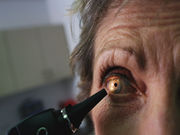Prasugrel has no increased ocular risk versus clopidogrel; dabigatran, rivaroxaban may reduce risk
THURSDAY, Dec. 14, 2017 (HealthDay News) — Prasugrel carries no increased ocular risk compared with clopidogrel, and dabigatran and rivaroxaban may reduce risk compared with warfarin, according to a study published online Dec. 14 in JAMA Ophthalmology.
Katherine E. Uyhazi, M.D., Ph.D., from the University of Pennsylvania Perelman School of Medicine in Philadelphia, and colleagues compared patients with incident use of dabigatran etexilate or rivaroxaban (64,291 patients) with patients with incident use of warfarin sodium (146,137 patients), and compared new use of prasugrel hydrochloride (8,386 patients) with clopidogrel bisulfate (103,796 patients). The main outcome was incident intraocular hemorrhages at 90 and 365 days.
The researchers found that the risk of developing an intraocular hemorrhage was reduced with dabigatran or rivaroxaban at 365 days (hazard ratio, 0.75; 95 percent confidence interval, 0.58 to 0.97; P = 0.03) but not at 90 days (hazard ratio, 0.73; 95 percent confidence interval, 0.22 to 2.63; P = 0.13). There was no increased risk of developing an intraocular hemorrhage for patients taking prasugrel versus clopidogrel at 90 days (hazard ratio, 0.75; 95 percent confidence interval, 0.29 to 1.92; P = 0.55) or 365 days (hazard ratio, 1.19; 95 percent confidence interval, 0.69 to 2.04; P = 0.53).
“These results suggest a decreased risk of intraocular hemorrhage associated with novel direct thrombin inhibitors and direct factor Xa inhibitors, but no difference for P2Y12 inhibitors compared with traditional vitamin K anticoagulation and antiplatelet therapy, respectively,” the authors write.
Copyright © 2017 HealthDay. All rights reserved.








